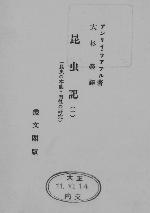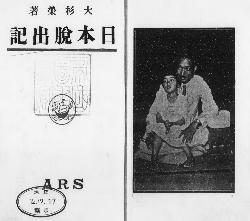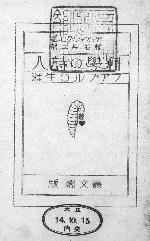![]()
Section 4: The individuals involved with Fabre's Book of Insects
Jean Henri Fabre's (1823-1915) Fabre's Book of Insects ended up being much more famous in Japan, than in his own country of France. In 1919, Christian pacifist KAGAWA Toyohiko (1888-1960) first introduced Fabre to Japan. Thereafter, anarchist OSUGI Sakae (1885-1923) began working on a complete translation and publication of Fabre's Book of Insects from 1922. In the Meiji Era world of scholars and journalists, the introduction of the theory of evolution by KATO Hiroyuki (1836-1916), OKA Asajiro (1868-1944) and others was active, however KAGAWA, OSUGI and others who rose to prominence in the Taisho Era were critical of the theory of struggle for existence as a result of the influence of Pyotr Alekseevich Kropotkin's (1842-1921) Mutual Aid: A Factor of Evolution. OSUGI's translation selected traces of mutual aid in the instincts of the insects depicted so lively by Fabre, and also had an aspect of criticizing the principle of competition in a capitalist society. Translators of Fabre's Book of Insects have included KIDA Minoru (YAMADA Yoshihiko, 1895-1975), who studied under Marcel Mauss (1872-1950), and others, many of whom pondered the relationships between modern society and individuals.
Jean Henri Fabre, ŌSUGI Sakae and SHIINA Sonoji (Tr.), Konchūki, Sōbunkaku, 1922-1926 [385-207] 
OSUGI was raised in a military family, and enrolled in the Army Cadet School, however ended up being expelled as the result of a fight with a classmate. Thereafter, he enrolled in the French Studies course at the Tōkyo School of Foreign Languages (present day Tokyo University of Foreign Studies), visited KOTOKU Shusui (1871-1911) and others from the Heimin Shinbun newspaper [WB43-71] in the Yanaka Village Incident, and entered the world of social activism. OSUGI played a significant role in the activism after KOTOKU and others were executed in the High Treason Incident of 1910. He set the objective, "one language per arrest", and learned one new language each time he was imprisoned, earning his living through translation and writing. In 1919, while imprisoned in Toyotama Prison for physical assault on a policeman, he read the abridged English translation of Fabre's Book of Insects and determined to translate it himself. He used a French language original (illustrated) published the same year as his source text, and it was published by Sobunkaku. In the translator's foreword, OSUGI states that he truly admired Fabre's observations of scarabaeus sacer (dung beetle), stating, "The dung beetle's ecology is truly brought to life!", seemingly overlapped his thesis of “improving life,” which gives high place to individuality and freedom. OSUGI also translated Charles Robert Darwin's (1809-1882) On the Origin of Species.
ŌSUGI Sakae, Nihon dasshutsuki, Arusu, 1923 [514-185] 
In 1922, in order to participate in the International Congress of Anarchists which was to be held in Berlin in the following year, OSUGI travelled to France via Shanghai using a false passport, and stayed in a working class district in Paris. It seems that compared to Paris seen by OSUGI at the time, the comfort of Japan's urban living was superior to that of Paris, where his lodgings had no electrical lighting or toilet. In May of the following year, he was arrested for giving an unscheduled speech on Mayday, and was detained at the Prison de la Santé before being forcibly deported. This work is a description of these experiences, and was a posthumous work for OSUGI, who together with ITO Noe (1895-1923), was murdered in the Amakasu Incident of the Tokyo Earthquake of 1923 that September. The publisher Ars was operated by KITAHARA Hkushu's (1885-1942) younger brother Testsuo (1887-1957), and was known for its beautiful bookbinding. The inside cover of the work reprints the expulsion decree issued by the French government, and the frontispiece features a photo of OSUGI holding his older daughter Mako (1917-1968). The work also features a poem which begins, "Mako, dear Mako, papa is now, in the famous, Paris Prison la Santé."
Georges Victor Legros, SHIINA Sonoji (Tr.), Kagaku no shijin, Sōbunkaku, 1925 [544-128] 
After OSUGI's death, the Sobunkaku edition translation of Fabre's Book of Insects was taken over by SHIINA Sonoji (1887-1962). At the time, SHIINA had returned to Japan with his French wife and child and was working as an instructor at Waseda University. He was friends with ISHIKAWA Sanshiro (1876-1956) and held a system of beliefs close to that of anarchy. In 1927, he again travelled to France. Under the German occupation, he collaborated with the resistance and later died in Paris in 1962.
This work is a biography compiled during Fabre's life by his apprentice Georges Victor Legros (1862-?). Fabre was born in a poor village in the south of France, and while working as a school teacher also studied mathematics and natural history on his own. His method of observing the ecology of living insects was a novel approach at the time, and while it proved to be extremely accurate, it was not accepted in academic circles and he continued his research in poverty. He did not accept the theory of evolution before his death because it is not based on observation, however Darwin praised Fabre as a great observer. In Japan, the "country of dragonflies" of Judith Gautier, Fabre's Book of Insects found a number of passionate readers.
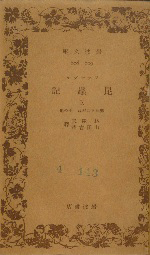
Jean Henri Fabre, HAYASHI Tatsuo and YAMADA Yoshihiko (Tr.), Konchūki, Iwanami shoten, 1930-1958 [569-14]
The Iwanami Bunko (Iwanami collection) version of Fabre's Book of Insects was the most reprinted complete translation, and was a translated over a period of more than 20 years around World War II by HAYASHI Tatsuo (1896-1984) and YAMADA Yoshihiko. HAYASHI was known as a liberal intellectual with encyclopedia knowledge, but just who was YAMADA Yoshihiko? YAMADA was an author who was known under the penname "KIDA Minoru" after the war. He was supported by Joseph Cotte (1875-1949), the founder of the French language school Athenee Francais, and went to Paris to study abroad on a French government scholarship in 1934, and studied anthropology under Marcel Mauss. OKAMOTO Taro (1911-1996) was a fellow student. After returning to Japan, he lived in a poor village in Hachioji, Tokyo and garnered attention by using this as a field to discuss the foundations of Japanese culture. Regarding meeting KIDA, HAYASHI explains, "This was the beginning of my relationship with this gentleman with his strange appeal, and soon my name was also on the Iwanami Bunko (Iwanami Collection) version of Fabre's Book of Insects and I found myself having a hand in its translation. From that point on my relationship, good and bad, with him, and with Fabre continued for 30 years."
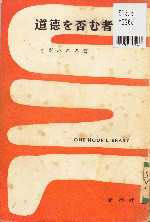
KIDA Minoru, Dōtoku o inamu mono, Shinchōsha, 1955 [913.6-Y226d]
This is an autobiographical novel written by KIDA on the occasion of his teacher, Cotte's death, and recollects the first half of KIDA's life. He was born to a doctor's family on Amami Oshima Island. His family then moved to Keelung Taiwan, where his father was assigned, and KIDA became sick as a result of the difficult life there, and was forced to transfer schools to Tokyo. He was neglected at his uncle's house where he stayed and decided to try to kill himself by leaping into Tokyo Bay, however he was unable to bring himself to do and seeking help he visited the Hokkaido Trappist Monastery, where he gained the friendship of Cotte who was visiting due to troubles with his treatment at Tokyo Imperial University. Thereafter, KIDA was brought up by Cotte and showed development of his mind and body that differed from other Japanese, and became the first staff and later an instructor at the Athenee Francais school established by Cotte, who had quit the university. Before long, at 39 years of age as a private citizen, he was exceptionally selected for a French government scholarship to study abroad. In this work he speaks of how he was drawn to the sight of Japan seen from the Kanmon Strait on his ship voyage back to Japan, and 15 years later KATO Shuichi (1919-2008) would share the same experience (the sea route was used until the 1950's). KIDA's interests then turned toward the basic structures underlying Japanese society.

